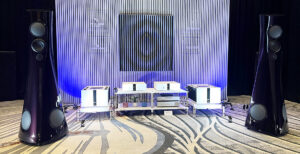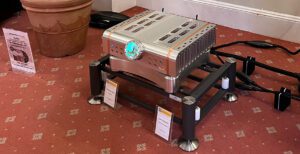
In case you hadn’t heard, the ‘Q’ suffix in the upcoming AKG N90Q stands for ‘Quincy’. This $1,499 state of the art noise-cancelling closed back headphone was designed in association with legendary producer Quincy Jones – and it’s suggested that it really was ‘in association’. Quincy Jones didn’t just put his name to this headphone, he was central to the inclusion of key aspects of the design.
Unlike other noise cancelling headphones in the AKG range, the N90Q’s active cancelation circuit has no passive option – if the headphones aren’t powered, they aren’t making a sound. But, a part of this comes down to a level of sophistication to the active circuitry inside the headphone. Fortunately, AKG realised that a pair of headphones that potentially run out of juice and turn silent mid-way across the Atlantic might not be a good idea, so the travel case comes with a rechargeable power bar (which, as the N90Q is powered through USB, can also charge a smartphone).

A USB connection isn’t just for charging. The headphones also have an inbuilt USB DAC for HD Audio playback. In this case, ‘HD’ means 24/96 playback. This represents a potentially great pathway opening up for higher-performance listening direct from the computer or smartphone source, without having to rely on either an external DAC/amp or the built in versions inside a phone or PC. Whether using headphone or DAC, the right earcup doubles up as a rotary volume control, while the left acts as a DSP-derived tone control (treble and bass boost). This was one of Quincy Jones key demands, because a purely flat response does not suit every music production.
Harman has been including a ‘stage control’ control in its headphones including JBL models. This is an attempt to remove through DSP the in-head or lateralisation effects of playing music through headphones. There are three spatial modes ‘standard’, ‘2.1 studio’ and ‘5.1 surround sound’. Frankly, I wasn’t convinced by this on JBL models and I’m not entirely convinced here, but that must be tempered by the N90Q being in not the best place for close listening and it being prototype samples, and so on. I also think your perception toward ‘stage control’ depends on both how acclimated you are toward headphone sound, and if your tastes tend toward the purist, or even the puritanical. I know many who think this an excellent inclusion to create a sense of 3D sound in the potentally 2D world between our ears, so try it for yourself.
I’m sort of saving the technological best until last, though. ‘TruNote’ technology allows the headphones to calibrate themselves to the ears of the listener. How this works in practise is you press and hold the ‘stage control’ button on the lower right ear-cup for a few second, the music mutes, you hear a couple of quick and quiet sweep tones in both ears, and the music is back. How this works is there is a built-in microphone in the ear-cup, which processes the tiny variations in sound pressure level it receives from that sweep, essentially ‘mapping’ your ear. This is slightly different from having CIEMs made for you, because this is more about frequency response than accuracy of fit. This is ultimately extremely clever, and extraordinarily effective – just listen to the N90Q calibrated for someone else’s ears, then calibrate it for your ears, and the difference is striking.
The American and European had an exclusive pre-release listen to these headphones and Harman’s outstanding flagship store in New York City. We also had a guided tour of the store prior to the event, and it’s a true destination audio store that should be on any serious music lover’s checklist. Aside from its home cinema (not a home cinema room, or home theatre room, it’s practically a cinema), the well-stocked audio demonstration room, and essentially a ‘wheel of headphones’, there is a soundproofed booth for more intense listening. Here, we had a chance to compare the N90Q against two similarly priced rivals; the Beyerdynamic T1 and Sennheiser HD800. These are two of the best-respected headphones from two of the best-respected brands, and the N90Q sounded at least as good as these industry giants. The T1 sounded slightly ‘richer’ and the HD800 slightly ‘brighter’ than the N90Q in its tonally flat position, but the N90Q had the option of tonal adjustment (among other options), and when you mapped the headphones to your ears, I found the N90Q to have a lot going for it.
The HD demonstration was difficult to test under the circumstances (even a soundproofed booth was not soundproofed enough to drown out the noise of New York’s Glitterati turning up to drink wine and meet Quincy Jones), but this gave a good measure of how successful the noise cancelation will be, and it’s extremely effective. Obviously, cancelation is more about lowering constant noises (like that inside an aircraft cabin) than ambient chatter, but the general noise of the crowd was significantly lowered by the cancelation.

Sometimes the link between ‘studio’ and ‘domestic’ is stretched a little, but AKG (and Harman itself) has a close link with the studio world. The N90Q is not a studio headphone, but it comes with a genuine and tangible link to the studio that can’t be ignored. Just how close that link actually is, and whether the sound of the prototypes (under inhospitable circumstances) matches up to the end result remains to be seen. But as of now, this is one of the most exciting high-end headphones we’ve seen. The Q might just have another hit on his hands!
We also received a pair of the brand new, super light, and super small $249 N60 noise cancelling headphones, and a long flight home. Guess what’s coming soon?
Tags: FEATURED
By Alan Sircom
More articles from this authorRead Next From Blog
See all
AXPONA 2024 Show Report Part One
- Apr 19, 2024

Audio Show Deluxe 2024: A photo show report
- Mar 28, 2024

Paul Messenger 1949-2024: A personal tribute
- Mar 26, 2024

Bristol Hi-Fi Show 2024: See You There!
- Feb 21, 2024










